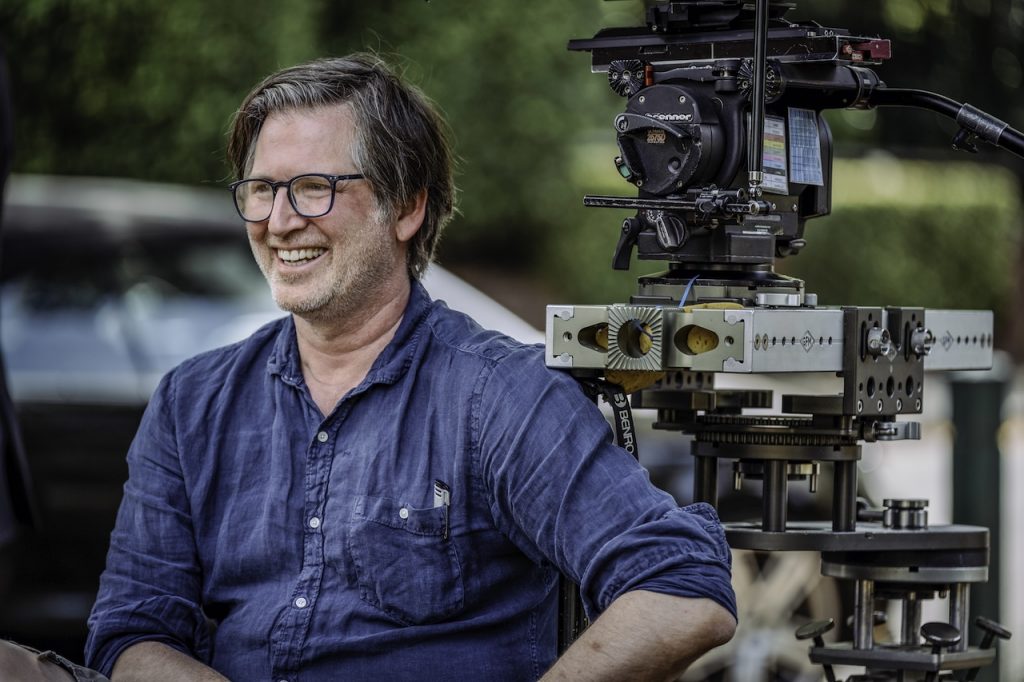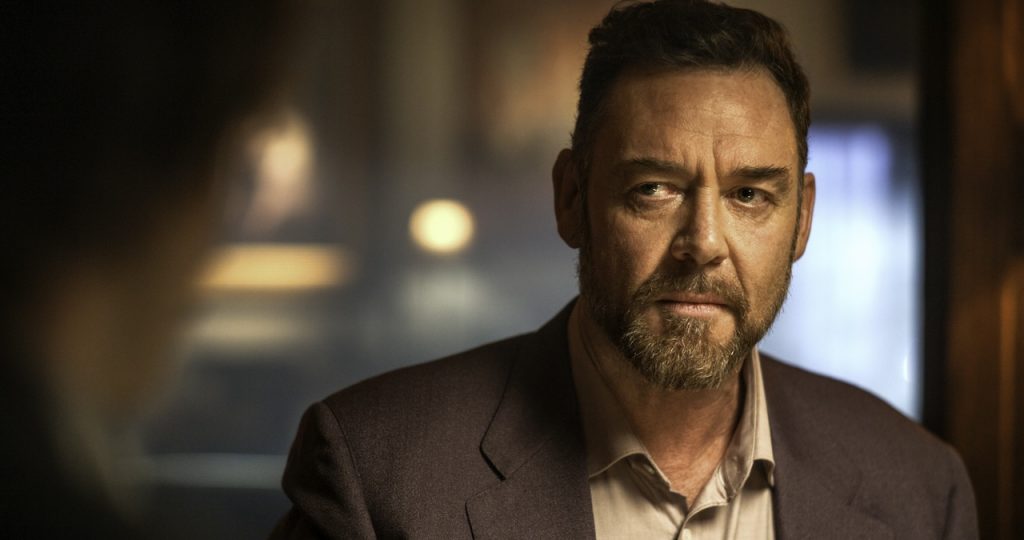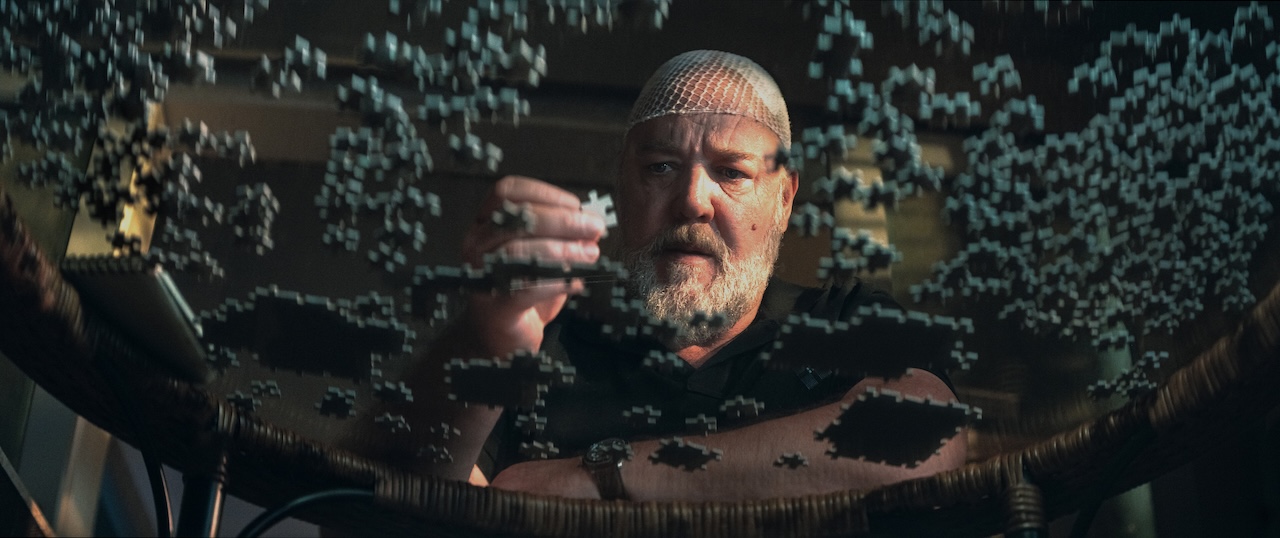This article contains mild spoilers.
Ex-homicide detective Roy Freeman (Russell Crowe), who suffers from early onset Alzheimer’s undergoes Deep Brain Stimulation (DBS) to regain his forgotten memories and solve a cold case murder mystery. That’s a lot to unpack in the opening scenes of Adam Cooper’s mystery thriller film Sleeping Dogs. The movie slowly unfolds as Freeman confronts his existential question of figuring out his identity. This slots in nicely with Cooper’s penchant for writing about characters in crisis as they struggle to make sense of their lives.
It all began when Pouya Shahbazian, a literary manager and producer, met screenwriter Adam Cooper on the set of Allegiant where they started discussing adapting the novel The Book Of Mirrors by E.O. Chirovici into a film which would eventually be named Sleeping Dogs. Cooper subsequently wrote a spec script with the intention of directing it. The option lapsed until producer Mark Fasano (Mother’s Day, American Ultra) came on board and reignited the project.
Sleeping Dogs is a gripping thriller about Roy Freeman with a fractured memory, forced to revisit a decades old murder case he can’t remember. As he pieces together the clues, a prisoner languishes on death row.
Freeman postures whether it’s sometimes better to uncover the truth or let sleeping dogs lie.
What Is Truth But A Fragile, Temporary Construct Of Subjective Memories?
Cooper responded to the novel’s exploration of the perception and subjective moulding of truth. “Oftentimes, truth is just a point of view of our memory of things in the past. Our recollections of them are not oftentimes exactly how they occurred.”
Our perception and awareness of events affect our memory of shaping them and the choices we make, even at a subconscious level. Roy Freeman is now devoid of any memory of the murder of college professor Jospeh Wieder (Márton Csókás), so he can arguably review the facts of the case with a more objective eye. This approach made the most sense to Cooper despite it being a major departure from the novel.

Adam Cooper. Photo courtesy of The Avenue
Adapting The Book Of Mirrors
The book is siloed into three major sections. “The first one is a New York literary manager who receives a partial manuscript that is The Book of Mirrors in the film. He reads it and then passes off what he learns to the second character who’s a New York investigative journalist who had investigated this murder twenty years prior. He carries the torch for a certain amount of narrative and then passes it off to the third character which is Roy Freeman.”
The film focuses on the final third section of the novel.
Freeman was responsible for putting a man on death row for the murder of the college professor. “We basically reframed the whole narrative through the lens of that character, and assigned action that was formerly assigned to other characters to Roy’s character, in order to give him a stronger narrative and emotional arc,” continues Cooper.
The novel focused more on the investigative journalism aspect of the story. Adam Cooper points out that the name change from the book to the movie is nuanced, but significant. “This gives you very different perspectives on how the story might play out.” Sleeping Dogs relates to the thematic climax whereas The Book Of Mirrors refers to the fleeting, fractured narratives that flawed memories can create.
“The book highlights that memories are sometimes reflections of other things. We came by the title Sleeping Dogs through what happens at the end of the film. It’s very much a story about a man who feels disconnected from life because he doesn’t have memory, and our memory is what gives us context for who we are, our friends, our family, and our social status. When memories are absent, we can feel lost isolated and confused. Freeman’s eager to regain his memory so he can essentially find and regain his place in the world.”
In doing so, he starts to reconnect and learn about who he once was. By the end of the film, he regrets undergoing the experimental Alzheimer’s treatment to restore his memories. Sometimes, it’s better to let Sleeping Dogs lie.
Writing A Tense Thriller
“I wanted to tell a compelling story in where you are in lockstep with the protagonist as the information comes out. There is no omniscient content in the film. You’re never with another character who is revealing information and puts the audience ahead of your protagonist,” says Cooper.

(Joseph Wieder) Márton Csókás. Photo courtesy of The Avenue
“I always wanted to be with Roy Freeman on his journey, so when he wakes up and he is confused, the audience is confused with him. When he is getting information for the first time, the audience is also getting that information for the first time.”
Sleeping Dogs is a slow burn movie that reveals itself as Freeman’s memories slowly come back to him. “There’s just enough revelation at every given moment to be forward-leaning for the audience. It’s kind of a long tease.”
Russell Crowe advocated for the character Jimmy Remis (Tommy Flanagan), Freeman’s former associate who reopens the case with him, to have “more substantive stakes rooted in his character’s backstory as it related to his involvement in the mystery. Russell had some really smart ideas to better highlight and create more suspicion around Jimmy Remis.” Adam Cooper highlights scenes where Freeman notices where he notices that his name isn’t on any of the sign-offs as an example.
The key thrust of commandeering a thriller lies in “trying to reconcile the mystery of the past with the clues in the present.” There were carefully added story breadcrumbs to keep the narrative exciting and interesting as they led to the ultimate mystery.
Roy Freeman’s mental state is traced in every scene until the nail-biting end. “We have led the viewer down a path where they believe that the movie is effectively over. I think they suspect all that is left is some kind of emotional resolve which I tried to lean into at the climax in the film,” states Cooper.
“I wanted to suggest that the mystery narrative, at this moment, appears to be over because all the characters that you’ve presented have been wrapped up in a certain way.” Until it flips.
“Roy is going into this last phase where everything feels resolved and we learn that elements of his memory have come back, yet we haven’t revealed the trauma that informs the mystery. I really wanted to punch the viewer in the stomach with what Roy Freeman is feeling. For me, it’s the most powerful moment in the film.”
Final Thoughts
We asked Adam Cooper on how Sleeping Dogs fits into the thriller landscape.
“There are definitely touchstones to films that I loved from the eighties. But, I feel like a lot of films in this genre don’t have a compelling central character narrative. Oftentimes, they’re very focused on the mystery and less on how does the character change or evolve during the course of the covering of that mystery.”
“What I’ve added to the genre is a compelling character story about a man coming to terms with who he really is and exploring the duplicity of character in this space.“
